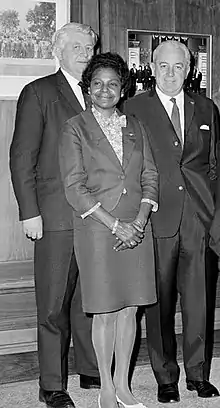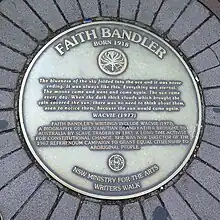Faith Bandler
Faith Bandler AC MBE (27 September 1918 – 13 February 2015; née Ida Lessing Faith Mussing) was an Australian civil rights activist of South Sea Islander and Scottish-Indian heritage. A campaigner for the rights of Indigenous Australians and South Sea Islanders, she was best known for her leadership in the campaign for the 1967 referendum on Aboriginal Australians.
Faith Bandler AC MBE | |
|---|---|
 Bandler meeting with Gordon Bryant (left) and Prime Minister Harold Holt in the lead-up to the 1967 referendum | |
| Born | 27 September 1918 |
| Died | 13 February 2015 (aged 96) |
| Spouse | Hans Bandler |
| Children | Lilon Gretl Bandler, Peter Bandler |
| Awards |
|
Early life and family
Bandler was born in Tumbulgum, New South Wales, and raised on a farm near Murwillumbah. Her father Wacvie Mussingkon, son of Baddick and Lessing Mussingkon, had been blackbirded from Biap, on Ambrym Island, in what is now Vanuatu as a boy, aged about 13 years, in 1883. He was then sent to Mackay, Queensland, before being sent to work on a sugar cane plantation. He later escaped and married Bandler's mother, a Scottish–Indian woman from New South Wales.
Mussingkon's abduction was part of blackbirding, the practice which brought cheap labour to help establish the Australian sugar industry. He was later known as Peter Mussing, a lay preacher and worked on a banana plantation outside Murwillumbah. He died when Bandler was five years old.[1] Bandler cited stories of her father's harsh experience as a slave labourer as a strong motivation for her activism.
In 1934, Bandler left school and moved to Sydney, where she worked as a dressmaker's apprentice.[2]
Career
Early career
During World War II, Bandler and her sister Kath served in the Australian Women's Land Army, working on fruit farms. Bandler and indigenous workers received less pay than white workers. After being discharged in 1945, she started to campaign for equal pay for indigenous workers. After the war, Bandler moved to the Sydney suburb of Kings Cross, New South Wales where she also worked as an abuse activist.[3]
Community activism
In 1956, Bandler became a full-time activist, co-founding and becoming active in the Sydney-based Indigenous rights organisation Aboriginal-Australian Fellowship along with Pearl Gibbs, Bert Groves,[4] and Grace Bardsley.[5]
Bandler also became involved with the Federal Council for Aboriginal Advancement (FCAA, later FCAATSI), which was formed in 1957. During this period, Bandler worked with her mentors Pearl Gibbs and Jessie Street. As general secretary of FCAA, Bandler led the campaign for a constitutional referendum to remove discriminatory provisions from the Constitution of Australia. The campaign, which included several massive petitions and hundreds of public meetings arranged by Bandler, resulted in the 1967 referendum being put to the people by the Holt government. The referendum succeeded in all six states, attracting nearly 91 percent support across the country,[6] which gave the Federal Government the power to make laws for Indigenous Australians in states, as well as including them in population counts (the Australian census).[7]
In 1975, Bandler visited Ambrym Island, where her father had been kidnapped 92 years before.[8] Throughout the 1970s, Bandler was a prominent member of the Women's Electoral Lobby in New South Wales.[9]
Writing

In 1974, Bandler started working on four books, two histories of the 1967 referendum, an account of her brother's life in New South Wales, and a novel about her father's experience of blackbirding in Queensland. Beginning in 1974, she also started campaigning for the rights of South Sea Islander Australians. According to Bandler's biographer, feminist writer and historian Marilyn Lake, this campaign was more challenging than the FCAATSI campaign for the 1967 referendum, since Bandler was fighting on two fronts. Not only was she battling historians who insisted that the blackbirded South Sea Islanders were actually voluntary indentured servants, but she was also to some extent ostracised by indigenous Australians in the Australian civil rights movement, due to the increasing influence of separatist Black Power ideology.[10]
Personal life
In 1952, Faith married Hans Bandler, a Jewish refugee from Vienna, Austria, and lived in Frenchs Forest. During the war, Hans had been interned in the Nazi labour camps.
The couple had a daughter, Lilon Gretl, born in 1954, and a fostered Aboriginal Australian son, Peter (Manual Armstrong). However, they lost touch with Peter when he later left to find his own family.
Hans died in 2009. Faith Bandler died at the age of 96 in February 2015.[11]
Honours and awards
Bandler was:
- appointed a Member of the Order of the British Empire (MBE) in 1976,[12] but she declined to accept it[13]
- appointed a Member of the Order of Australia (AM) on 11 June 1984, in recognition of her service to Aboriginal welfare[14]
- awarded an honorary doctorate from Macquarie University in 1994[15]
- awarded the 1997 Human Rights Medal by the then Human Rights and Equal Opportunity Commission
- named as one of the 100 inaugural Australian Living Treasures by the National Trust of Australia
- invested as a Companion of the Order of Australia (AC) on 26 January 2009 (Australia Day)[16][17]
- included on the Victorian Honour Roll of Women in 2001
A 1993 portrait of Bandler by artist Margaret Woodward is held by the State Library of New South Wales.[18]
Following her death, Prime Minister Tony Abbott offered Bandler's family a state funeral.[19]
Selected works
Bandler's published works include:
- Bandler, Faith (1977). Wacvie. Adelaide: Rigby. ISBN 0-7270-0446-8.
- Bandler, Faith; Fox, Len (1980). Marani in Australia. Adelaide: Rigby. ISBN 0-7270-1254-1.
- Bandler, Faith; Fox, Len, eds. (1983). The Time was Ripe: A History of the Aboriginal-Australian Fellowship. Chippendale, New South Wales: Alternative Publishing Cooperative. ISBN 0-909188-78-5.
- Bandler, Faith (1984). Welou, My Brother. Glebe, New South Wales: Wild & Woolley. ISBN 0-909331-73-1.
- Bandler, Faith (1989). Turning the Tide: A Personal History of the Federal Council for the Advancement of Aborigines and Torres Strait Islanders. Canberra: Aboriginal Studies Press. ISBN 0-85575-196-7.
References
- Stephens, Tony. "Bandler, Ida Lessing Faith". Obituaries Australia. Australian National University. Retrieved 20 December 2015.
- "Famous Australians – Faith Bandler". Behind the News. Australian Broadcasting Corporation.
- "Faith Bandler Activist, author and inspiration". The Australian. 14 February 2014.
- "Aboriginal-Australian Fellowship". A History of Aboriginal Sydney. 29 June 2020. Retrieved 2 December 2020.
- "Three Tributes to Pearl Gibbs" (PDF). Aboriginal History. 7 (1 (1901-1983)). 1983. Retrieved 2 December 2020 – via Australian National University.
- "Referendum Dates and Results". Australian Electoral Commission. Retrieved 22 March 2015.
- Taylor, Russell (26 May 2017). "Indigenous Constitutional Recognition: The 1967 Referendum and Today". Parliament of Australia. Papers on Parliament no. 68. Retrieved 2 December 2020.
- "Australian Biography: Faith Bandler". National Film and Sound Archive. Retrieved 18 February 2022.
- Summers, Anne (24 February 2015). "Faith and Feminism: Memorial Service for Faith Bandler, Great Hall Sydney University". Retrieved 19 January 2019.
- Lake, Marilyn (2002). Faith: Faith Bandler, Gentle Activist. Crows Nest, New South Wales: Allen & Unwin. ISBN 1-86508-841-2.
- "Political activist and writer Faith Bandler AC dies aged 96". ABC News. 13 February 2015. Retrieved 13 February 2015.
- "ILF Bandler, MBE". Australian Honours. Australian Government.
the source refers to "Mr" ILF Bandler", but this is clearly a misprint)
- Moore, Clive R. "Bandler, Ida Lessing Faith (1918–2015)". Pacific Islander Biography. Retrieved 9 August 2017.
- "Ida Lessing Faith BANDLER". Australian Honours Search Facility, Dept of the Prime Minister and Cabinet. Retrieved 6 November 2020.
- "Faith Bandler aggregated collection of papers, 1875, 1945-2008". SLNSW catalogue. Retrieved 31 January 2017.
- Franklin, Katie (27 January 2009). "Beazley heads Australia Day honours list". ABC News.
- "Faith Bandler awarded AC for indigenous campaign". 29 April 2009.
- "Faith Bandler, 1993/painted by Margaret Woodward". Catalogue entry. State Library of New South Wales. 2007. Retrieved 4 November 2009.
- "Aboriginal rights activist Faith Bandler dies aged 96". The Guardian. Australian Associated Press. 14 February 2015. Retrieved 14 February 2015.
External links
- "Faith Bandler" (Interview). Interviewed by Carolyn Craig. State Library of New South Wales. 1997. Retrieved 15 May 2018.
- Ryan, Lyndall (May 2003). "Review of Marilyn Lake's biography of Faith Bandler – Faith: Faith Bandler, Gentle Activist". Australian Humanities Review. 29. Archived from the original on 10 April 2018. Retrieved 1 May 2009.
- "Faith Bandler". Collaborating for Indigenous Rights 1957 – 1973. National Museum of Australia. Archived from the original on 24 June 2014.
- "Faith Bandler". National Museum of Australia. Archived from the original on 11 June 2011.
- Bandler, Faith at The Encyclopedia of Women and Leadership in Twentieth-Century Australia